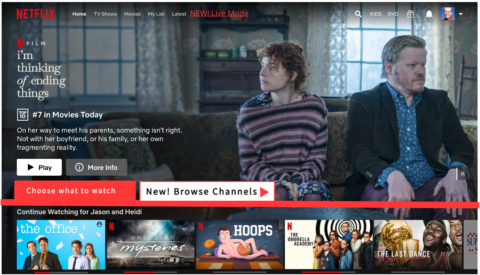Everything goes in cycles. The seasons, cultural trends, and basically every aspect of the internet rises and falls, with all that is old becoming new again (AskJeeves should be rebooted any day now). With that maxim in mind, I think it’s a perfect time for Netflix to keep ahead of its increasingly aggressive competition in the streaming space by launching a new product called Netflix Live.
Why Netflix Live?
You might think this sounds crazy given that Netflix is reaching increasing new heights with binge-watching at the center of its brand. To be clear, I’m not suggesting Netflix abandon the immense value in choice and binge viewing. Rather, they continue to innovate by adding to their offerings with a “Live” mode that offers up current Netflix offerings in a traditional “Channels” format. In this approach, content airs aligned to time blocks like over-the-air television has done since day one.
Not only would this “Live” approach enable Netflix members to avoid the paradox of choice (on average, it takes us seven minutes to find what to watch), a “Live” mode would also recall a nostalgic period in its members’ lives, when we flipped around channels and watched whatever happened to be on at a given time.
How would it work?
Netflix Live mode would mirror most of the existing Netflix library of content, though instead of being arranged into main categories for members to browse through, Live mode would be organized in the manner of traditional, over-the-air broadcast TV networks.
When you load Netflix by default, you’d still see the default method of browsing for content. However, by clicking a toggle, tab, or other element, you’d be taken into “Live” mode, where all content would be arranged by “Channels” in the traditional sense, with specific shows and movies airing at specific blocks of time as you’d find when browsing your cable TV channel guide.

Think obvious channels aimed organized by genre like comedy, drama, teens and kids, but also imagine the possibilities of more unique channel options, wherein Netflix can itself — with its vast array of content — become almost a full replacement for your linear cable TV guide, though with even more modern channel offerings. A few examples:
- “Saturday afternoon movies” (replicating the fading habit of getting sucked into whatever random “classic” movie TBS happens to be airing);
- “Picked for Me”, a channel built on a specific members’ tastes, with a mix of both preferred shows as well as suggested new offerings;
- “Network-style”, where channels feature either a literal line-up of shows from a specific broadcast network (tricky as each network launches its own platform), or “simulated networks”, where particular channels show a mix of comedy, drama, and kids programming based on time-of-day.
Value beyond novelty
Beyond the novelty value to viewers and tons of earned media that “Live” mode would likely generate, Netflix “Live” could also be a new avenue for Netflix to find audiences for its increasingly deep bench of shows by exposing them to viewers in a more passive way. For example, imagine if instead of offering you to watch the next episode of the office, Netflix auto-played another sitcom (from its in-house library, or that of another studio) immediately after?
I believe that baking in this sense of “discovery” into the overall experience of Netflix would reach both older / less sophisticated users migrating away from cable (and even antenna), while also appealing to veteran streaming viewers overwhelmed by the scope of available content and seeking a more refreshing combination of choice combined with curated delivery.
While I’m sure Netflix needs to continue promoting its most expensive content front-and-center, it certainly wouldn’t hurt to continue pushing top shows while also working to increase ratings across the long tail of its catalog, especially if renewal agreements with partners were staked to certain engagement metrics.
More than discovery: affinity through appointment viewing
With this approach, Netflix could also challenge linear networks and streaming competitors like HBO MAX (who dole out episodes weekly) by creating its own sense of appointment viewing. Want to watch all the new episodes of Stranger Things back-to-back? Use the Netflix you’re used to. But if you want to sit down on say Friday nights with friends or family and watch the show unfold week-over-week, Netflix “Live” would give you that option as well. While bingeing is likely tied to deeper engagement, I can also see a case where viewers having deeper, longer-lasting affinity when they can engage with a show over time and in less of a rush.
Live mode could also lay the groundwork for Netflix to explore moving into actual live content – either cannabalizing or supporting broadcast TV networks with another avenue to reach their viewers.
Peacock already has the jump on Netflix and other streamers
Speaking of which, in the time between when I started this post as a draft and finally published it, a broadcast network streaming service has already beaten Netflix to the punch with its own version of “Live” mode. The newly-launched Peacock streaming service, run by NBC, has a “Channels” tab on the service, where members can browse through offerings in a more linear, time-based approach. There are currently niche-specific channels such as news, all Law and Order, all Unsolved Mysteries, and others. While this early offering doesn’t deliver much value in terms of true variety or “chance viewing”, it certainly does put Peacock ahead of Netflix, Hulu, and other streamers still relying on their homepage to drive viewers to content in what I think will become an outdated “tip-of-the-iceberg” style approach to surfacing content from their increasingly huge content libraries.

Back to the Future
There are many smart reasons for Netflix — or any other streaming platform — to experiment with a “Live” viewing option. Whether it be to entice members with a novelty approach to viewing, reduce choice inertia, or expose its deep catalog of content, there are benefits to members of Netflix as it seeks to retain and grow its audience amidst increasing competition. For Netflix itself, the benefits are also many: from the ability to intentionally surface up targeted content, increase viewership of its long tail, or explore a reach into literal live TV viewing, the time is now for Netflix to continue its history of innovation with a fun and smart new foray … into the past.


Leave a Reply